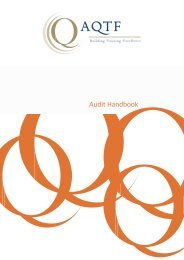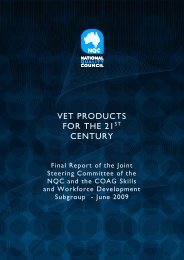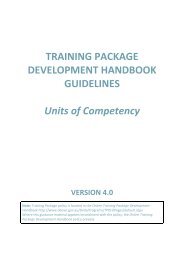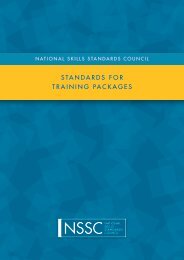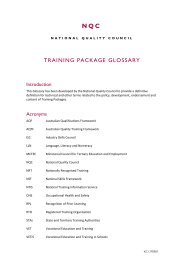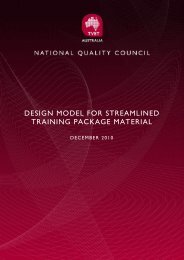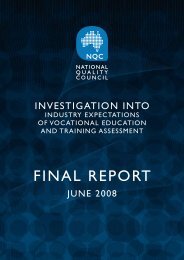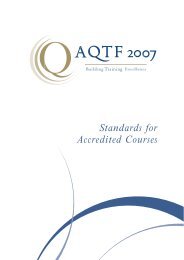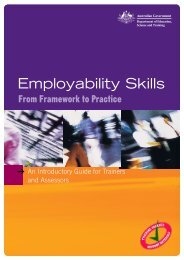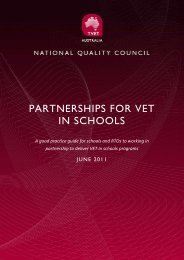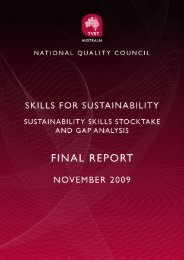Training package development handbook guidelines
Training package development handbook guidelines
Training package development handbook guidelines
Create successful ePaper yourself
Turn your PDF publications into a flip-book with our unique Google optimized e-Paper software.
TRAINING PACKAGE<br />
DEVELOPMENT HANDBOOK<br />
GUIDELINES<br />
Qualifications Framework<br />
VERSION 3<br />
Note: <strong>Training</strong> Package policy is located in the Online <strong>Training</strong> Package Development<br />
Handbook http://www.deewr.gov.au/Skills/Overview/Policy/TPDH/Pages/main.aspx<br />
Where this guidance material appears inconsistent with the policy, the Online <strong>Training</strong><br />
Package Development Handbook policy prevails.<br />
GuidelinesQualFrameworks_V3_June 2010 V3 June 2010 Page 1 of 28
GUIDELINES: QUALIFICATIONS FRAMEWORK<br />
CONTENTS<br />
GUIDELINES: QUALIFICATIONS FRAMEWORK ................................................................. 3 <br />
Introduction ..........................................................................................................................................................3<br />
1. Advice on <strong>Training</strong> Package pathways .....................................................................................................3<br />
1.1 Before commencing training ...............................................................................................................3<br />
1.2 During training.....................................................................................................................................5<br />
1.3 After training .......................................................................................................................................5<br />
1.4 Articulation, pathways and recognition by professional bodies .........................................................6 <br />
2. Australian Apprenticeships........................................................................................................................9 <br />
3. Australian Qualification Framework alignment ......................................................................................9<br />
4. Coding and titling for qualifications........................................................................................................10 <br />
4.1 Coding and titling maintenance for qualifications.............................................................................10<br />
5. Contextualisation of qualifications ..........................................................................................................12<br />
6. Credit transfer and articulation...............................................................................................................12<br />
7. Employability Skills Summaries..............................................................................................................12<br />
8. Importing qualifications ...........................................................................................................................13<br />
9. Mandatory text..........................................................................................................................................13<br />
10. Mapping of qualifications....................................................................................................................13<br />
11. Packaging qualifications—models and issues to consider.................................................................14<br />
11.1 Core‐only model ................................................................................................................................15 <br />
11.2 Core and electives model ..................................................................................................................15<br />
11.3 Core and specialisation model...........................................................................................................16<br />
11.4 Core, specialisation and electives model...........................................................................................17<br />
11.7 Electives‐only model..........................................................................................................................18<br />
11.5 Weighting systems.............................................................................................................................19<br />
11.6 Language, Literacy and Numeracy (LLN) ...........................................................................................19<br />
11.7 Access and equity ..............................................................................................................................20<br />
11.8 OHS....................................................................................................................................................20<br />
11.9 Environmental issues.........................................................................................................................20<br />
12. Pre-requisite units of competencies ....................................................................................................20<br />
12.1 Effect of pre‐requisites in qualifications............................................................................................22<br />
13. Skill Sets ................................................................................................................................................24<br />
13.1 Definition...........................................................................................................................................24<br />
13.2 Identifying Skill Sets in <strong>Training</strong> Packages .........................................................................................24<br />
13.3 Skill Set design ...................................................................................................................................24<br />
13.4 Examples of Skill Sets in <strong>Training</strong> Packages .......................................................................................25<br />
13.5 Statements of Attainment.................................................................................................................27<br />
14. Specialisations in qualifications...........................................................................................................28<br />
14.1 Units of competency used in more than one qualification ...............................................................28<br />
GuidelinesQualFrameworks_V3_June 2010 V3 June 2010<br />
Page 2 of 28
Guidelines: Qualifications Framework<br />
Introduction<br />
The Qualifications Framework is one of the endorsed components of a <strong>Training</strong> Package.<br />
In Australia, the Australian Qualifications Framework (AQF) defines all nationally recognised<br />
qualifications, and, in the VET sector, nationally recognised AQF qualifications are provided through<br />
endorsed <strong>Training</strong> Packages and accredited courses as follows.<br />
• In endorsed <strong>Training</strong> Packages, qualifications are created by combining units of competency into<br />
meaningful groups aligned to the AQF and endorsed by the National Quality Council (NQC)<br />
within the <strong>Training</strong> Package Qualifications Framework.<br />
• In courses, accredited by State or Territory course accrediting bodies where there is no relevant<br />
endorsed <strong>Training</strong> Package and an industry or community need has been identified,<br />
qualifications can be based on:<br />
- a combination of units of competency from one or more <strong>Training</strong> Packages, or groups of<br />
endorsed units of competency<br />
- units of competency, for example specific enterprise units of competency<br />
- modules incorporating learning outcomes, where the course developer can show it is not<br />
possible to develop units of competency.<br />
Increasingly, VET qualifications derive from <strong>Training</strong> Packages.<br />
1. Advice on <strong>Training</strong> Package pathways<br />
Pathways are generally defined as a path or sequence of learning or experiences that can be<br />
followed to attain competency.<br />
Specific pathways are not mandatory and may vary depending on the qualification or training<br />
program, and the needs of the individual.<br />
Pathway advice should be provided in the <strong>Training</strong> Package in relation to requirements before,<br />
during and after training (in acknowledgment that learners can achieve the requirements of a<br />
qualification in various ways).<br />
1.1 Before commencing training<br />
Provide advice in the <strong>Training</strong> Package on any need to hold particular units of competency or<br />
qualifications before training or assessment commences—for example in relation to licensing or<br />
safety considerations.<br />
These requirements should be expressed in terms of the path that someone may follow before<br />
commencing training and should assist RTOs in:<br />
• Designing the most appropriate delivery program.<br />
• Advising students prior to enrolment of specific pathway requirements.<br />
• Assessing student applications.<br />
• Providing suitable RPL processes.<br />
Because of the nature or specialisation of some qualifications or training programs, candidates may<br />
be better equipped to undertake the training and assessment if they bring with them prior<br />
GuidelinesQualFrameworks_V3_June 2010 V3 June 2010 Page 3 of 28
knowledge, skills and experience. Where this is so, entry requirements, or advice on pathways into<br />
the training, should be specified for the qualification or training program.<br />
Entry requirements do not form part of the qualification, but are specific to the knowledge, skills or<br />
experience required to enter a qualification.<br />
They should be expressed in terms of competency, units of competency or equivalent, and may<br />
include licensing or industry recognised standards.<br />
Entry requirements do not have to be specified for a qualification. However, if they are specified,<br />
caution should be applied as they can significantly reduce the flexibility of a qualification and limit<br />
entry of potential learners.<br />
Entry requirements may be expressed as:<br />
• The core units of competency of a lower level AQF qualification or equivalent skills and<br />
knowledge.<br />
• A significant number of units of competency from a lower level AQF qualification or equivalent<br />
skills and knowledge.<br />
• Specialist units of competency from a related stream or equivalent skills and knowledge.<br />
EXAMPLE<br />
Before commencing the PUA31102 Certificate III in Public Safety (Driving in a Threat Environment)<br />
candidates must hold a current drivers licence.<br />
or<br />
The following units of competency should be achieved either before or while undertaking HLT42507<br />
Certificate IV in Allied Health Assistance:<br />
• HLTHIR301A Communicate and work effectively in health<br />
• HLTAH301A Assist with an allied health program<br />
• HLTIN301A Comply with infection control policies and procedures in health work<br />
• HLTCSD201B Maintain high standard of client service<br />
• HLTCSD305B Assist with client movement<br />
• HLTAP301A Recognise healthy body systems in a health care context<br />
• BSBMED201A Use basic medical terminology<br />
EXAMPLE<br />
Pathways into the qualification<br />
Preferred pathways for candidates considering BSB40507 Certificate IV in Business Administration<br />
include:<br />
• after achieving the BSB30407 Certificate III in Business Administration or other relevant<br />
qualification/s<br />
OR<br />
• providing evidence of competency in the majority of units required for the BSB30407 Certificate III<br />
in Business Administration or other relevant qualification/s<br />
OR<br />
• vocational experience in providing administrative or operational support to individuals and/or<br />
GuidelinesQualFrameworks_V3_June 2010 V3 June 2010 Page 4 of 28
teams but without a formal business administration qualification.<br />
Examples of indicative job roles for candidates seeking entry based upon their vocational experience<br />
include:<br />
• Accounts Receivable Clerk<br />
• Accounts Payable Clerk<br />
• Clerk<br />
• Data Entry Operator<br />
• Junior Personal Assistant<br />
• Medical Records Officer<br />
• Receptionist<br />
• Office Administration Assistant<br />
• Office Administrator<br />
• Word Processing Operator.<br />
This breadth of expertise would equate to the competencies required to undertake this qualification.<br />
EXAMPLE ‐ qualifications<br />
In CPC31108 Certificate III in Steelfixing<br />
The construction industry strongly affirms that training and assessment leading to<br />
recognition of skills must be undertaken in a real or very closely simulated workplace<br />
environment and this qualification requires all units of competency to be delivered in this<br />
context.<br />
Completion of the general induction training program specified by the National Code of<br />
Practice for Induction <strong>Training</strong> for Construction Work (SAC 2006) is required before entering<br />
a construction worksite. Achievement of unit CPCCOHS1001A covers this requirement.<br />
1.2 During training<br />
Include advice in the <strong>Training</strong> Package about the range of pathways that may be taken to<br />
successfully complete a qualification or a program of training. For example:<br />
• Work‐based training and assessment.<br />
• Institution‐based training and assessment.<br />
• A combination of work‐based and institution‐based training and assessment.<br />
• Assessment only.<br />
• Recognition of prior learning (RPL).<br />
• Recognition of current competency (RCC).<br />
• A combination of training and assessment and RPL..<br />
1.3 After training<br />
While it is not mandatory to provide advice in a <strong>Training</strong> Package on pathways after the completion<br />
of a qualification or training program, such advice can be useful.<br />
Advice could be provided about typical job roles or further study an individual may take after<br />
completing the qualification or training program.<br />
This includes advice on possible career pathways and the linkages the qualification or training<br />
program has with higher AQF level qualifications.<br />
Advice provided in the <strong>Training</strong> Package should assist RTOs to in turn advise participants on the<br />
GuidelinesQualFrameworks_V3_June 2010 V3 June 2010 Page 5 of 28
possible options to move between education or training programs or into employment.<br />
EXAMPLE<br />
After completing the BSB50107 Diploma of Advertising, candidates may undertake the BSB60107<br />
Advanced Diploma of Advertising, or seek work as an:<br />
• Account Manager<br />
• Advertising Creative Director<br />
• Advertising Manager<br />
• Copywriter<br />
• Media Manager<br />
OR<br />
After completing ICA40805 Certificate IV in Information Technology (Multimedia) a graduate may<br />
seek work as a web designer or in on‐line service support.<br />
1.4 Articulation, pathways and recognition by professional bodies<br />
As appropriate, any recognition and agreed articulation arrangements of the <strong>Training</strong> Package<br />
qualifications, pathways and any recognition by professional bodies should be detailed.<br />
EXAMPLE<br />
The qualifications contained within the <strong>Training</strong> Package now form the basis for membership of the<br />
Australian Computer Society (ASC). In principle agreement by the ASC will allow for:<br />
• an individual who is undertaking qualifications up to and including Certificate IV can seek<br />
student membership with the ACS; and<br />
• an individual who has achieved a Diploma can seek Associate Membership status with the ASC.<br />
A clear qualifications pathways chart must be included in the <strong>Training</strong> Package at the end of the<br />
Qualifications Framework section. This should clarify all qualifications including any Australian<br />
Apprenticeship pathways.<br />
The following sample qualifications pathways charts are provided to show the type of information<br />
that may be included. (They are simplified versions of existing <strong>Training</strong> Package qualifications<br />
pathways charts.) Add contact details of the Industry Skills Council into the chart for enquiries about<br />
pathways and qualifications.<br />
GuidelinesQualFrameworks_V3_June 2010 V3 June 2010 Page 6 of 28
NATIONAL COMMUNITY RECREATION<br />
INDUSTRY TRAINING PACKAGE<br />
Sport and Recreation Qualifications<br />
Certificate I in Sport and Recreation<br />
Certificate II in Sport and Recreation<br />
Certificate IV in Sport and Recreation<br />
Diploma of Sport and Recreation<br />
Advanced Diploma of Sport and Recreation<br />
Community Recreation Qualifications<br />
Certificate I in Community Recreation<br />
Certificate II in Community Recreation<br />
Certificate III in Community Recreation<br />
Certificate III in Community Recreation<br />
(Instruct)<br />
Certificate IV in Community Recreation<br />
Diploma of Community Recreation<br />
GuidelinesQualFrameworks_V3_June 2010 V3 June 2010 Page 7 of 28
Aeroskills Qualifications<br />
and Pathways<br />
Aeroskills <strong>Training</strong><br />
Direct Entry Point<br />
Direct Entry Point<br />
Certificate IV<br />
in Aeroskills<br />
(Avionics)<br />
Aviation<br />
Maintenance<br />
Technician<br />
Certificate IV<br />
in Aeroskills<br />
(Mechanical)<br />
Aviation<br />
Maintenance<br />
Technician<br />
Certificate IV<br />
in Aeroskills<br />
(Structures)<br />
Aviation<br />
Maintenance<br />
Technician<br />
Certificate II in Aeroskills (Avionics)<br />
Choices across Avionics, Maintenance or Structures<br />
Recognition of Prior Learning<br />
Relevant Industry Experience<br />
and/or Qualifications<br />
GuidelinesQualFrameworks_V3_June 2010 V3 June 2010 Page 8 of 28
2. Australian Apprenticeships<br />
Advice must be provided on Australian Apprenticeships pathways for all qualifications in the <strong>Training</strong><br />
Package. An example is shown below.<br />
EXAMPLES<br />
Australian Apprenticeships Pathways<br />
• Qualifications included in this <strong>Training</strong> Package can be achieved by a variety of pathways and<br />
delivery methods—either on‐the‐job or through a combination of on‐ and off‐the‐job training<br />
and recognition processes.<br />
• With the exception of Certificate I (the main objective of which is to facilitate VET in schools and<br />
initial entry to the industry) all other qualifications can be achieved through contracted training<br />
including Australian Apprenticeships.<br />
• Qualifications at AQF levels II and III particularly facilitate Australian Apprenticeship pathways.<br />
They provide multiple entry and exit points and promote efficient use of learning strategies and<br />
articulation arrangements.<br />
• The Diploma in (Specialisation) may not be appropriate for an Australian Apprenticeship<br />
pathway in a majority of workplaces because of the specialist nature of the skills included and<br />
the unusual level of accountability in the usual job role.<br />
Any qualifications not available through an Australian Apprenticeships pathway must be identified,<br />
along with industry advice as to why this is the case.<br />
3. Australian Qualification Framework alignment<br />
The Australian Qualification Framework (AQF) covers all nationally recognised qualifications in<br />
Australia, across the three sectors—schools, VET and higher education. The AQF Implementation<br />
Handbook provides a comprehensive guideline for each AQF qualification and should be referred to<br />
for more detailed information. It can be obtained from www.aqf.edu.au/<br />
There are currently eight competency‐based qualifications identified for the VET sector. These are<br />
shown below, grouped according to the educational sector responsible for their accreditation.<br />
Source: AQF website www.aqf.edu.au<br />
GuidelinesQualFrameworks_V3_June 2010 V3 June 2010 Page 9 of 28
Individual units of competency are not aligned to the AQF; alignment occurs when a group of units<br />
of competency equate to a viable AQF qualification or qualifications. In arriving at an AQF alignment<br />
for groups of units of competency, developers should consult with the relevant industry about the<br />
appropriate use of individual units, including any pre‐requisite relationships.<br />
When referring to units of competency in the <strong>Training</strong> Package Qualification Framework, reference<br />
should be to the specific AQF qualification title such as Certificate I, Certificate II and so on—not to<br />
‘AQF levels’. The AQF has qualifications used in the schools sector sit below Certificate I—therefore<br />
any reference to ‘AQF levels’, for example calling Certificate I ‘Level I’, is potentially confusing and<br />
inaccurate.<br />
There is no requirement that the full range of possible VET sector qualifications should be available<br />
in one <strong>Training</strong> Package. However, developers should consider including Certificate I or II<br />
qualifications to provide entry to the industry and meaningful pathways to further training and<br />
employment. This is particularly important for groups and individuals who may have been<br />
disadvantaged in their access to vocational education and training.<br />
A number of factors will contribute to the ‘user friendliness’ of the explanation of the qualifications<br />
framework for readers of the <strong>Training</strong> Package:<br />
• grouping all of the units of competency that make up a qualification together wherever practical<br />
• clearly stating the number of units required to achieve a particular qualification, avoiding terms<br />
which can be interpreted in various ways, for example maximum or minimum number of units<br />
• using wherever possible the terms listed in the packaging models advice in this document rather<br />
than developing new terms which may confuse some users<br />
• providing a well presented diagram or table showing the relationship between all the identified<br />
qualifications in the <strong>Training</strong> Package and if appropriate any relationships with qualifications<br />
from other endorsed <strong>Training</strong> Packages.<br />
4. Coding and titling for qualifications<br />
<strong>Training</strong> Package qualification codes and titles must comply with the policies in the Online <strong>Training</strong><br />
Package Development Handbook. Each <strong>Training</strong> Package qualification has a unique eight‐character<br />
code. An example is provided below.<br />
AQF<br />
level<br />
}<br />
Year of<br />
endorsement<br />
}<br />
AUM30108 Certificate III in Automotive Manufacturing<br />
}<br />
This identifies the<br />
<strong>Training</strong> Package<br />
(in this case<br />
Automotive)<br />
}<br />
Position in<br />
qualification<br />
sequence<br />
4.1 Coding and titling maintenance for qualifications<br />
If qualifications are added to a <strong>Training</strong> Package during its period of endorsement, developers should<br />
consult the Online <strong>Training</strong> Package Development Handbook.<br />
GuidelinesQualFrameworks_V3_June 2010 V3 June 2010 Page 10 of 28
As an example, if the following qualifications at Certificate III in a particular industry sector in the<br />
‘XYZ’ <strong>Training</strong> Package were endorsed in 2008:<br />
XYZ30108<br />
XYZ30208<br />
XYZ30308<br />
XYZ30408<br />
XYZ30508<br />
… and if a new Certificate III qualification was added in 2009, its code would be:<br />
XYZ30609.<br />
Changes to a qualification can be:<br />
• minor upgrades made by the developer or ISC, which do not require code and/or title changes,<br />
or<br />
• major changes made by the developer that require NQC endorsement and involve code and/or<br />
title changes.<br />
The difference between the changes is explained below.<br />
ISC Upgrade:<br />
Any changes to a qualification that do not change the outcome are considered ISC Upgrades. Such<br />
changes include, but are not limited to:<br />
• One or more endorsed units is added to or deleted from elective list – code and title remains the<br />
same.<br />
• The units within a qualification are updated to a later equivalent version (including core and<br />
elective units of competency and any pre‐requisite units of competency).<br />
NQC Endorsement Required:<br />
Any changes to a qualification that changes the outcome must have the version of the code changed<br />
(e.g. CUV40303 would become CUV40309, or a later code if the later has already been allocated) and<br />
be submitted for NQC endorsement. This includes, but is not limited to:<br />
• Pre‐requisite units are added to or removed from the core units within a qualification.<br />
• Change to core unit.<br />
• One or more endorsed units is added to or deleted from the core.<br />
• A new stream is added to a qualification (which could include a number of new units).<br />
• There is a change in the number of units required for a qualification.<br />
NOTE: Interim arrangements are in place until 31 December 2010 to reflect the NQC resolution<br />
below.<br />
At its 8 April 2010 meeting, NQC agreed:<br />
(a) to amend the <strong>Training</strong> Package Development and Endorsement Process 2008 to allow for<br />
an ISC upgrade to apply where the qualification packaging rules and qualification structure<br />
have been changed to reflect the new packaging rules for flexibility and the embedding of<br />
green skills in <strong>Training</strong> Packages;<br />
GuidelinesQualFrameworks_V3_June 2010 V3 June 2010 Page 11 of 28
(b)<br />
(c)<br />
(d)<br />
that the amendment allows ISCs to transition qualifications to the new packaging rules for<br />
flexibility, and the embedding of green skills, where the qualification outcomes and<br />
structure have not substantially changed and where the ISC determines that there is no<br />
need to seek industry validation via a full endorsement process;<br />
that the proposed amendment to the <strong>Training</strong> Package Development and Endorsement<br />
Process 2008 apply until 31 December 2010 to align with the end date for transition to<br />
new packaging rules for flexibility and embedding of green skills in <strong>Training</strong> Packages;<br />
that the following communication processes will be required to support the amendment:<br />
i. ISCs notify and explain ISC upgrades to State <strong>Training</strong> Authorities and the NQC<br />
ii. ISCs update the <strong>Training</strong> Package version and the version modification history to<br />
explain in detail the particulars of the change<br />
iii. ISCs publish the change to NTIS.<br />
5. Contextualisation of qualifications<br />
Contextualisation of qualifications allows substitution of some units of competency in qualifications<br />
where this is consistent with the described work outcome and outlined in the qualification’s<br />
packaging rules. The substitution may be with units <strong>package</strong>d in other qualifications in the same<br />
<strong>Training</strong> Package, or from other endorsed <strong>Training</strong> Packages; such contextualisation must not distort<br />
the qualification purpose or its alignment to the AQF.<br />
Advice on allowable contextualisation of qualifications must be included in the <strong>Training</strong> Package. The<br />
advice must clearly set out the boundaries to contextualisation to ensure users can readily<br />
determine what is acceptable to industry. The advice could be developed around scenarios or<br />
examples of typical job roles, or could be a list of what is allowable and what is not (‘do’s and<br />
don’ts’), and could include the:<br />
• codes and titles of units of competency that can be substituted for specified units in the <strong>Training</strong><br />
Package<br />
• relevant <strong>Training</strong> Packages from which the units can be drawn<br />
• AQF qualifications in which any specified units are used in the source <strong>Training</strong> Package.<br />
6. Credit transfer and articulation<br />
In determining packaging rules, developers should attempt to optimise opportunities for credit<br />
transfer arrangements between VET and higher education qualifications where applicable, while also<br />
meeting industry needs.<br />
7. Employability Skills Summaries<br />
An Employability Skills Summary describes Employability Skills requirements at a qualification level.<br />
These summaries are the minimum, mandatory Employability Skills requirement for the endorsed<br />
components of <strong>Training</strong> Packages—they summarise the Employability Skills that are embedded in<br />
the units that make up the qualification.<br />
The Employability Skills Summaries provide a lens through which to view these skills at the<br />
qualification level; they capture the key aspects or facets of the Employability Skills important to the<br />
GuidelinesQualFrameworks_V3_June 2010 V3 June 2010 Page 12 of 28
job roles covered by the qualification. Summaries are designed to assist trainers and assessors to<br />
identify and include the important industry application of Employability Skills in learning and<br />
assessment strategies.<br />
Employability Skills Summaries can be developed at any stage of the <strong>Training</strong> Package <strong>development</strong><br />
process. While most ISCs develop them from the information contained within the units of<br />
competency, they can also be designed on the basis of job role and occupational functional analyses.<br />
The Employability Skills Summaries will also be subject to industry validation throughout the <strong>Training</strong><br />
Package process. Tool 9 contains further information and an example of a completed Employability<br />
Skills Summary.<br />
More detailed information on Employability Skills can be found within the TPDH Guidance: Units of<br />
Competency.<br />
8. Importing qualifications<br />
In importing qualifications from other endorsed <strong>Training</strong> Packages, developers must follow the<br />
policy as set out in the Online <strong>Training</strong> Package Development Handbook; the policy clearly sets out<br />
the rules for importing qualifications.<br />
9. Mandatory text<br />
To ensure accuracy of information and consistency between <strong>Training</strong> Packages, mandatory text is<br />
included in each <strong>Training</strong> Package.<br />
The Content Authoring Tool (CAT) User Guide (introduced from mid 2007 to facilitate the<br />
<strong>development</strong> of <strong>Training</strong> Packages for publication on the NTIS) provides instructions for adding<br />
industry‐specific text into the CAT files. When the <strong>Training</strong> Package is loaded to NTIS using the CAT<br />
files, the <strong>Training</strong> Package mandatory text will be automatically included.<br />
However, for a transition period, the <strong>Training</strong> Package ‘Interim Maintenance Process’ (IMP) device<br />
for making changes to <strong>Training</strong> Packages will continue. Developers are advised to seek clarification<br />
from the relevant DEEWR officer.<br />
If using the CAT, refer to the CAT User Guide and associated templates. Developers not using the CAT<br />
should go to the downloads page for the mandatory text. Do not change the mandatory text, apart<br />
from adding information at the prompt: [INSERT].<br />
10. Mapping of qualifications<br />
Developers must provide clear information mapping the qualifications to those in previous versions<br />
of the <strong>Training</strong> Package. The policy in the Online <strong>Training</strong> Package Development Handbook clearly<br />
sets out the positioning of this information.<br />
GuidelinesQualFrameworks_V3_June 2010 V3 June 2010 Page 13 of 28
11. Packaging qualifications—models and issues to consider<br />
Each <strong>Training</strong> Package provides details of those units of competency that must be achieved to award<br />
each endorsed AQF qualification it contains. The rules around which units of competency can be<br />
combined to make up a valid AQF qualification in the <strong>Training</strong> Package are referred to as the<br />
‘packaging rules’. The packaging rules must be followed to ensure the integrity of nationally<br />
recognised qualifications.<br />
Although the AQF descriptors for each vocational qualification are broad, and can overlap to some<br />
extent, each AQF qualification must have a distinct vocational outcome. While flexible packaging<br />
approaches are preferred to provide for industry use, care must be taken to ensure that choices do<br />
lead to distinct AQF qualifications outcomes.<br />
In developing qualifications, units of competency are grouped and <strong>package</strong>d into meaningful<br />
workplace combinations reflecting complete and recognisable job roles. These provide the<br />
boundaries agreed by industry as essential for competent performance in an area of work.<br />
Combinations of units of competency must be flexible enough to ensure qualifications can be used<br />
by a diverse range of small, medium and large enterprises, while still being meaningful across the<br />
industry as a whole. This ensures national recognition and portability of industry relevant workplace<br />
competencies.<br />
The same units of competency can still be used in different qualifications where necessary, but each<br />
qualification must be clearly differentiated from preceding or subsequent qualifications and clearly<br />
meet the AQF descriptor. In particular, higher level qualifications should be carefully constructed to<br />
meet this requirement.<br />
The packaging rules provide a coherent structure to the qualifications and include the number and<br />
details of units of competency (including any imported units of competency and prerequisite units of<br />
competency) that make up the qualifications.<br />
When writing the packaging rules for a qualification clearly state the number of units required to<br />
achieve a particular qualification, avoiding terms which can be interpreted in various ways, for<br />
example, ‘maximum’ or ‘minimum’ in referring to a number of units.<br />
Within a single <strong>Training</strong> Package different packaging models may be used. Developers must ensure<br />
that the way units of competency are grouped and <strong>package</strong>d results in qualifications with a broad<br />
range of relevant competencies that a majority of employers will find sufficient for typical job roles.<br />
There are five main packaging models:<br />
• core‐only model<br />
• core and electives model<br />
• core and specialisation model<br />
• core, specialisation and electives model<br />
• electives‐only model.<br />
The most commonly used packaging models include combinations of core and elective, or core and<br />
specialist units of competency. Core‐only models exist, but these are rare as they can potentially<br />
reduce <strong>Training</strong> Package flexibility and limit industry or enterprise use; elective‐only models are also<br />
infrequently used as they can result in combinations of competencies that do not reflect realistic<br />
workplace outcomes.<br />
GuidelinesQualFrameworks_V3_June 2010 V3 June 2010 Page 14 of 28
11.1 Core‐only model<br />
In this model all the units of competency making up a qualification are core units—they must all be<br />
achieved for the awarding of the qualification. While this approach is not a common one, as it<br />
provides no flexibility in structure and assumes all workplaces require exactly the same competency<br />
application, it may sometimes be required by industry.<br />
If a core‐only qualification is identified it should be fully justified in the <strong>Training</strong> Package Case for<br />
Endorsement, and advice provided to users about its rationale and industry need. This need must<br />
have been established and agreed through wide consultation and have industry support.<br />
EXAMPLE<br />
Certificate II in Animal Studies<br />
To gain the Certificate II in Animal Studies the following units must be completed:<br />
• Carry out reception duties<br />
• Carry out daily clinic routines<br />
• Carry out surgery preparations<br />
• Follow occupational health and safety procedures<br />
• Use hazardous substances safely<br />
• Communicate in the workplace<br />
• Act to minimise emergencies and respond to a variety of situations<br />
• Plan daily work routines<br />
This qualification has only core units as the Certificate II workplace outcome has restricted duties,<br />
generally under the supervision of qualified veterinarian or veterinary nurse. Units from the<br />
Certificate II qualification lead to the Certificate IV in Veterinary Nursing.<br />
11.2 Core and electives model<br />
The model with a core of mandatory units and choice from a group of units as electives is a common<br />
qualification packaging approach. The core defines the competencies critical for all workplaces and<br />
the electives provide the breadth of skills to meet the needs of diverse enterprises with varying skill<br />
combinations and work organisation approaches.<br />
To ensure maximum flexibility the core should not be too large and there should be meaningful<br />
choice in the electives – this will provide considerable flexibility. However, if industry agrees that the<br />
most appropriate qualification has a large core of mandatory units and a limited number of electives<br />
this must be justified and fully explained in the endorsement submission. The key to this approach is<br />
to ensure there is enough cohesion in units to be meaningful and acceptable for a range of work<br />
across the industry, whatever combination of electives is chosen.<br />
EXAMPLE<br />
Certificate III in Information Technology<br />
This qualification requires achievement of 11 units of competency comprising 5 core units and six<br />
electives.<br />
Core Units:<br />
• Develop macros and templates for clients using standard product<br />
GuidelinesQualFrameworks_V3_June 2010 V3 June 2010 Page 15 of 28
• Customise <strong>package</strong>d software applications for clients<br />
• Provide advice to clients<br />
• Use advanced features of computer applications<br />
• Create user and technical documentation<br />
Electives:<br />
Choose any six units, up to two of which can be drawn from any other nationally endorsed <strong>Training</strong><br />
Package (please refer to the section on customisation of qualifications which provides advice on the<br />
appropriate selection of units from other <strong>Training</strong> Packages).<br />
• Maintain equipment and software in working order<br />
• Connect internal hardware components<br />
• Install network hardware to a network<br />
• Create code for applications<br />
• Install and optimise system software<br />
• Run standard diagnostic tests<br />
• Migrate to new technology<br />
• Operate system software<br />
• Install and manage network protocols<br />
• Relate to clients on a business level<br />
• Provide basic system administration<br />
• Install software to networked computers<br />
• Provide network systems administration<br />
• Provide one‐to‐one instruction<br />
• Administer network peripherals<br />
• Create web pages with multimedia<br />
• Apply skills in project integration<br />
Note: Advice in the contextualisation section of <strong>Training</strong> Packages should clearly explain the<br />
boundaries for incorporating units from other endorsed <strong>Training</strong> Packages. This would typically<br />
cover the appropriate alignment of source qualifications and may specify which industry <strong>Training</strong><br />
Packages would be relevant.<br />
11.3 Core and specialisation model<br />
This variation on the core and electives model is another popular approach. Again there is a core of<br />
essential units but under this model a choice is made from defined groups of units – specialisations –<br />
rather than a choice between individual units. There may also be elective choices within the<br />
specialisation groups that the packaging rules should clearly explain.<br />
This is a useful model where particular specialisations are widely recognised in an industry in<br />
addition to a shared set of skills covered by the core units. The approach also avoids inappropriate<br />
elective choices being made from a large group of units that would not lead to any particular<br />
recognised specialisation.<br />
GuidelinesQualFrameworks_V3_June 2010 V3 June 2010 Page 16 of 28
EXAMPLE<br />
Certificate IV in Veterinary Nursing<br />
The qualification comprises the mandatory core units and a choice of either the surgical or dental<br />
specialisation groups. All units in the chosen specialisation must be achieved.<br />
Core Units:<br />
• Apply haematology and blood chemistry tests, radiography and other test procedures<br />
• Co‐ordinate theatre routines<br />
• Carry out nursing procedures for routine surgery<br />
• Implement clinic office routines<br />
• Provide specific animal care advice<br />
Surgical specialisation:<br />
• Carry out admission and discharge of patients undergoing specialised surgical procedure<br />
• Carry out specialised surgical nursing procedures<br />
• Facilitate/supervise operating theatre maintenance<br />
• Manage the maintenance of surgical clothing and instruments<br />
Dental specialisation:<br />
• Carry out admission and discharge of dental patients<br />
• Manage instrument and equipment maintenance<br />
• Produce oral cavity radiographs<br />
• Perform dental prophylaxis<br />
• Provide veterinary nursing support for dental surgery<br />
Note: In core and specialisation models, the same unit can be used in more than one group, and can<br />
also be included in groups at different qualification outcomes.<br />
11.4 Core, specialisation and electives model<br />
This approach tends to be used for larger, more complex qualifications, covering a wide range of skill<br />
areas. It is useful where the qualifications structure accommodates multi‐skilling or a range of<br />
previously separate occupational specialisations.<br />
There may be different combinations of units that meet certain jurisdictional licensing requirements<br />
and these can be identified through this approach.<br />
This model usually comprises a small core of essential units, a choice between specialisation groups<br />
and an additional or alternative choice from a group of individual units.<br />
EXAMPLE<br />
Certificate III in Wildlife Protection<br />
This Certificate requires completion of 12 units of competency in total. These must comprise the 6<br />
mandatory core units plus all units from any one of the three specialisation groups and any three<br />
units from the elective bank. The Certificate may also be gained by achieving competency in any two<br />
of the specialist groups without utilising the elective options.<br />
GuidelinesQualFrameworks_V3_June 2010 V3 June 2010 Page 17 of 28
Core ‐ complete all<br />
• Unit 1<br />
• Unit 2<br />
• Unit 3<br />
• Unit 4<br />
• Unit 5<br />
• Unit 6<br />
Sector specialisation A (all units required)<br />
• Unit 7<br />
• Unit 8<br />
• Unit 9<br />
Sector specialisation B (all units required)<br />
• Unit 10<br />
• Unit 11<br />
• Unit 12<br />
Sector specialisation C (all units required)<br />
• Unit 13<br />
• Unit 14<br />
• Unit 15<br />
Elective bank ‐ choose any 3 units<br />
• Unit 16<br />
• Unit 17<br />
• Unit 18<br />
• Unit 19<br />
• Unit 20<br />
• Unit 21<br />
• Unit 22<br />
• Unit 23<br />
• Unit 24<br />
• Unit 25<br />
11.7 Electives‐only model<br />
Another less structured approach is to simply indicate the minimum number of units, drawn from a<br />
single overall group aligned to a particular qualification. In this approach developers must ensure<br />
that <strong>Training</strong> Package users are provided with sufficient information for them to be in a position to<br />
make an informed choice.<br />
Insufficient packaging information under this model may lead to an inappropriate mix of<br />
competencies and may not be regarded in industry as a useful combination of skills for typical<br />
workplace roles.<br />
GuidelinesQualFrameworks_V3_June 2010 V3 June 2010 Page 18 of 28
EXAMPLE<br />
Certificate I in Transport & Distribution (Road Transport)<br />
Requirements for completion of the qualification (any 7 of the following units):<br />
• Drive vehicles<br />
• Ride courier/delivery bicycles<br />
• Shift materials safely<br />
• Use manual handling equipment<br />
• Participate in workplace communication<br />
• Carry out workplace calculations<br />
• Follow occupational health and safety procedures<br />
• Conduct housekeeping activities<br />
• Conduct cleaning in enclosed spaces<br />
• Work effectively with others<br />
• Undertake workplace orientation<br />
• Complete induction procedures<br />
While clearly many combinations of the units would be viable Skill Sets, it may be possible to put<br />
together units meeting the packaging rules that would have a limited credibility with employers. A<br />
user guide with model training programs for commonly valued workplace roles is advisable if using<br />
an elective‐only approach.<br />
11.5 Weighting systems<br />
Weighting systems may be used to assist in designing and explaining flexible packaging<br />
arrangements. An acceptable weighting system is one where units of competency aligned to a<br />
qualification, or at least those in an elective bank, are assigned a number value.<br />
Only one weighting value can apply to a single unit of competency in a <strong>Training</strong> Package whether<br />
based on its combination with other units or its place in the whole Qualifications Framework.<br />
Weighting systems can only be used to determine a qualification outcome through packaging rules.<br />
A weighting system does not carry over to other <strong>Training</strong> Packages. Some <strong>Training</strong> Packages have<br />
assigned a number or point value equating to the unit’s initial alignment in the Qualifications<br />
Framework. Units can be aligned to more than one qualification; however if this is done the assigned<br />
number value must be derived from the lowest qualification that includes the unit and this value<br />
used throughout the <strong>Training</strong> Package. The packaging rules must describe how qualifications are<br />
achieved by referring to the total number of ‘points’ which must be gained.<br />
11.6 Language, Literacy and Numeracy (LLN)<br />
LLN must be considered when packaging qualifications and aligning groups of units to the AQF.<br />
The increasing complexity of LLN is not tied to AQF qualifications but to specific job requirements.<br />
For example, a Certificate II in the industry area of retail may have higher speaking and listening<br />
requirements than say a Certificate II in the manufacturing industry, whereas the Certificate II in the<br />
manufacturing industry may have higher numeracy and measurement requirements. Therefore,<br />
there may be variations in LLN requirements within a given AQF qualification level.<br />
GuidelinesQualFrameworks_V3_June 2010 V3 June 2010 Page 19 of 28
Developers are strongly advised to read the NRS Workplace Sample Activities—these provide a<br />
valuable resource with industry validated sample activities aligned against the five levels of the NRS.<br />
Go to www.dest.gov.au/ty/litnet/docs/NRS_Sample_Activities.pdf<br />
11.7 Access and equity<br />
It is important that developers consider implications for all potential clients when developing the<br />
packaging rules for qualifications. Issues in relation to access and equity include:<br />
• providing flexibility in qualifications packaging to eliminate (as far as possible) disadvantage to<br />
clients by enabling choice from a wide range of electives and giving consideration to horizontal<br />
as well as vertical skills pathways. This is particularly important in relation to learners with<br />
disability and the reasonable adjustments that they are entitled to under the DDA and Standards<br />
(to the extent those adjustments do not cause an education provider unjustifiable hardship or<br />
compromise the academic integrity of a course or program) – the key is capacity to achieve the<br />
essential competency, not necessarily the means by which that is achieved<br />
• considering the needs of some learners in remote communities who may have very specific<br />
needs for training because of limited employment opportunities available in their locality. The<br />
capacity to import units of competency from other <strong>Training</strong> Packages may be especially helpful<br />
for these clients by adding to the diversity of their skills<br />
• limiting core‐only qualifications as they can pose difficulties. For example, rural or remote clients<br />
who have limited workplace or training opportunities in their locality may not be able to achieve<br />
the full qualification locally or people with disability might not be able to achieve all units (and<br />
where these skills are not essential in the workplace)<br />
• eliminating any unnecessary pre‐requisite units of competency as they can create additional<br />
barriers for learners, especially learners with disability<br />
• considering the inclusion of Certificates I and II as they can provide an important pathway to<br />
entry level employment.<br />
11.8 OHS<br />
Where generic OHS competencies are incorporated into units of competency they should be<br />
contained within groups of units, as is normal practice, for the purpose of packaging and subsequent<br />
alignment.<br />
Specific OHS competencies covering specialist occupations, duties or particular hazards should be<br />
<strong>package</strong>d into groups of units—as core where they reflect workplace functions for all workers or as<br />
specialist or elective units where they reflect the needs of specialists, fewer workers or particular<br />
enterprises.<br />
11.9 Environmental issues<br />
Environmental matters may directly impact on qualifications. Where separate units of competency<br />
are included in <strong>Training</strong> Packages, their qualifications packaging will need to be considered. For<br />
example, the water industry has core environmental units at three AQF qualification levels. Other<br />
industries where environmental matters are incorporated into units have considered the<br />
environmental expectation of the various functions in their packaging at various AQF qualifications.<br />
12. Pre‐requisite units of competencies<br />
A pre‐requisite unit is a unit of competency in which the candidate must be deemed competent<br />
prior to the determination of competency in the unit.<br />
GuidelinesQualFrameworks_V3_June 2010 V3 June 2010 Page 20 of 28
Pre‐requisites in <strong>Training</strong> Package units of competency should only be used where it is critical to<br />
achieving the subsequent competency. Caution should be applied as these requirements can<br />
significantly reduce the flexibility of <strong>Training</strong> Package qualifications.<br />
Because pre‐requisites specify mandatory requirements before the candidate can be deemed<br />
competent in the higher or more complex unit, they are essential and are linked to the endorsement<br />
of those units. Thus pre‐requisites are included as part of a full qualification, contribute to the total<br />
outcome of the qualification, and are endorsed as part of the qualification packaging rules.<br />
Include advice clearly identifying all pre‐requisite requirements in the:<br />
• Pre‐requisite section of the affected unit of competency.<br />
• Unit of competency table in Volume 1 of the <strong>Training</strong> Package.<br />
• Qualification packaging rules for each qualification.<br />
Caution should be applied when including pre‐requisites as they can significantly reduce flexibility,<br />
particularly when such units are imported into other <strong>Training</strong> Packages. Developers that do not want<br />
to import pre‐requisite units should consider developing new unit/s to cover the appropriate range<br />
of skills and knowledge.<br />
EXAMPLE ‐ units<br />
PMAOHS312B Command the operation of survival craft<br />
Unit Descriptor:<br />
Operations technicians undertaking offshore operations can<br />
sometimes require evacuation involving the use of water craft and survival at sea. Due to the<br />
isolation of offshore installations and facilities, offshore evacuation procedures involve significant<br />
differences from standard onshore evacuation procedures.<br />
Employability Skills:<br />
Prerequisite Unit(s):<br />
This unit contains employability skills.<br />
MSAPMOHS220A Provide initial first aid response<br />
EXAMPLE ‐ units<br />
SITXFSA003A Transport and store food in a safe and hygienic manner<br />
Unit Descriptor:<br />
This unit describes the performance outcomes, skills and knowledge<br />
required to transport food from a food preparation area to another location. It also deals with<br />
holding or storage on its arrival. The unit applies to all catering operations but is particularly relevant<br />
to external catering and events. This unit does not cover the transport of food for room service<br />
which is covered in SITHFAB008A Provide room service. It does not cover the skills required to drive<br />
a van or truck which are covered in TDTC197B Drive vehicle and other units of competency in the<br />
Transport and Distribution <strong>Training</strong> Package.<br />
Transportation refers to the moving of food and food items from one location to another. For<br />
example, transporting food from a kitchen to a school or hospital or providing event catering. It does<br />
not refer to the transport of food from the kitchen to the dining room or as part of room service.<br />
Employability Skills:<br />
This unit contains employability skills.<br />
Prerequisite Unit(s): SITXFSA001A Implement food safety procedures and SITXOHS002A<br />
Follow workplace hygiene procedures<br />
GuidelinesQualFrameworks_V3_June 2010 V3 June 2010 Page 21 of 28
When developers wish to provide advice about pre‐requisite requirements that are not units of<br />
competency from a <strong>Training</strong> Package, they should provide this advice in the Application of the unit<br />
field.<br />
EXAMPLE ‐ units<br />
The unit PMASUP236B Operate vehicles in the field has no pre‐requisites. However operators will<br />
have the appropriate class of driver’s licence before taking charge of the vehicle.<br />
12.1 Effect of pre‐requisites in qualifications<br />
The following example qualification from the MSA07 <strong>Training</strong> Package, asterisks the units that have<br />
pre‐requisites. The qualification notes that the pre‐requisites units are to be counted in the total<br />
number of units required. The note at the end of the qualification then refers the reader to the<br />
prerequisite table of the unit of competency, or the actual unit of competency for details of the prerequisites.<br />
EXAMPLE ‐ qualifications<br />
MSA60108 Advanced Diploma of Manufacturing Technology<br />
This qualification is comprised of 30 units of competency and would normally be delivered part time over a<br />
four year period. There are five mandatory units that must be completed for all specialist streams as well as 25<br />
electives.<br />
This qualification has two specialist streams available. These are:<br />
• Metallurgy<br />
• Polymer Technology.<br />
Note that prerequisite units must be considered when elective units are chosen.<br />
Packaging Rules<br />
To be awarded an Advanced Diploma of Manufacturing Technology competency must be achieved in 30 units<br />
chosen as specified below.<br />
Mandatory units (all specialist streams)<br />
The following five units are compulsory for all specialist streams in the Advanced Diploma of<br />
Manufacturing Technology.<br />
Unit code<br />
Unit title<br />
MEM16006A Organise and communicate information<br />
MEM16008A Interact with computing technology<br />
MEM23001A Apply advanced mathematical techniques in a manufacturing engineering or related<br />
environment<br />
MEM30012A Apply mathematical techniques in a manufacturing engineering or related<br />
environment<br />
MSACMT251A Apply quality standards<br />
Pre‐requisites<br />
Units marked with an asterisk have one or more prerequisite requirements. The pre‐requisites for these units<br />
are to be counted in the total number of units required in the elective group. Please refer to the prerequisite<br />
table for details.<br />
GuidelinesQualFrameworks_V3_June 2010 V3 June 2010 Page 22 of 28
Elective units<br />
Choose 25 units as specified below for each specialist stream. (Note: only one stream is shown in this<br />
example.)<br />
Polymer technology specialist stream<br />
A minimum of 10 units must be chosen from groups 1 and 2 below. The balance (up to 15 units) can be chosen<br />
from the General Electives group. Units listed below as polymer technology specialist stream electives can also<br />
be taken as general electives.<br />
Group 1<br />
Choose at least one of the following units:<br />
Unit code<br />
Unit title<br />
PMBTECH601B Develop a new product *<br />
PMBTECH602B Develop a new die or tool *<br />
PMBTECH603B Design structural/mechanical polymeric components *<br />
Group 2<br />
Choose up to nine of the following units:<br />
Unit code<br />
Unit title<br />
MSACMT675A Facilitate the <strong>development</strong> of a new product *<br />
PMAOPS550B Develop a colour formulation<br />
PMAOPS600B Modify plant<br />
PMBTECH501B Analyse equipment performance *<br />
PMBTECH502B Review and analyse production trials and specify re‐trials *<br />
PMBTECH503B Determine rheology and output of plastics materials from processing *<br />
equipment<br />
PMBTECH504B Determine heat transfer loads for processing equipment *<br />
PMBTECH505B Choose polymer materials for an application *<br />
PMBTECH506B Analyse the design of products and tools *<br />
PMBTECH507B Develop fibre composite products using cored laminate techniques *<br />
PMBTECH508A Develop a new compound<br />
PMBTECH509A Modify an existing product<br />
PMBTECH510A Analyse failure in polymeric materials<br />
General<br />
electives:<br />
Pre‐requisites:<br />
Up to fifteen (15) of the twenty five (25) elective units may also be chosen from the<br />
general electives bank listed at the end of the specialist streams.<br />
Up to four (4) of the fifteen (15) units may be chosen from any other endorsed<br />
<strong>Training</strong> <strong>package</strong> where those units are available for inclusion at the Diploma level.<br />
Units marked with an asterisk have a prerequisite requirement. The pre‐requisites<br />
for those units are to be counted in the total number of units required in the elective<br />
group. Please refer to the prerequisite table or in the individual unit.<br />
The prerequisite table then includes the following information.<br />
Example – Units of competency in this <strong>Training</strong> Package and their pre‐requisites<br />
Code Title Prerequisite<br />
MSACMT675A Facilitate the <strong>development</strong> of a new product MSACMT452A<br />
Unit … …<br />
Unit … …<br />
GuidelinesQualFrameworks_V3_June 2010 V3 June 2010 Page 23 of 28
If there is a chain of pre‐requisites, that is, Unit C is a prerequisite for Unit B, which is a prerequisite<br />
for Unit A, the pre‐requisites must all be shown in the unit pre‐requisites table. The chain of prerequisites<br />
must be included in the total number of units required for the qualification.<br />
13. Skill Sets<br />
13.1 Definition<br />
Skill Sets are defined as single units of competency, or combinations of units of competency from an<br />
endorsed <strong>Training</strong> Package(s), which link to a licence or regulatory requirement, or defined industry<br />
need.<br />
13.2 Identifying Skill Sets in <strong>Training</strong> Packages<br />
On the basis of their research and industry consultation, developers of <strong>Training</strong> Packages have at<br />
least three options in relation to Skill Sets in a <strong>Training</strong> Package.<br />
• No national Skill Sets are identified for the <strong>Training</strong> Package.<br />
• Skill Sets are identified based on units from the <strong>Training</strong> Package.<br />
• Skill Sets are identified based on units from the <strong>Training</strong> Package combined with units from one<br />
or more other <strong>Training</strong> Packages.<br />
Skill Sets could be identified in a <strong>Training</strong> Package where the unit or group of units:<br />
• Meet requirements set by an agency external to the VET sector—for example, for a national<br />
licence, regulatory requirement or professional body membership.<br />
• Have a commonly understood meaning in the industry—for example, worksite induction<br />
requirements.<br />
• Constitute a specialist role that benefits from separate identification—for example, project<br />
management units that enable the individual to lead projects in their area of expertise.<br />
• Be a useful addition to a general qualification—for example Asian Cookery units added to a<br />
Hospitality qualification to provide a valuable extra set of skills; or a set of small business units<br />
that enable someone with a technical qualification to take on some specific small business<br />
functions.<br />
The <strong>Training</strong> Package should include all relevant information about the Skill Set. For example, in the<br />
first scenario above there might be additional requirements that need to be met such as using an<br />
assessor approved by the licensing authority, or paying additional fees.<br />
Provide information and advice about Skills Sets including:<br />
• Advice about other requirements of regulations that may need to be met such as any<br />
requirements for Australian citizenship or evidence of a certain period of work experience.<br />
• Advice about logical clusters that may meet industry needs.<br />
• Advice about pathways.<br />
• Advice about the circumstances under which Skill Sets, rather than a particular qualification,<br />
could be delivered – where this is appropriate.<br />
13.3 Skill Set design<br />
Developers should take the following points into account when designing Skill Sets:<br />
• <strong>Training</strong> Package developers should approach Skill Sets in the same way they approach the<br />
<strong>development</strong> of units of competency and qualifications. This includes considering logical skill<br />
GuidelinesQualFrameworks_V3_June 2010 V3 June 2010 Page 24 of 28
clusters that meet industry needs and have recognised value in the workplace, as well as<br />
ensuring industry consultation throughout the process.<br />
• Where Skill Sets are included in <strong>Training</strong> Packages, the target groups should be clearly defined.<br />
• The identification and <strong>development</strong> of Skill Sets within <strong>Training</strong> Packages should increase, rather<br />
than decrease, available skill <strong>development</strong> options for individuals and enterprises.<br />
• Consideration should be given to identifying clear relationships between Skill Sets or between<br />
Skill Sets and qualifications where this is appropriate.<br />
• Identified Skill Sets should be noted within the Qualifications section of the <strong>Training</strong> Package.<br />
• Where a <strong>Training</strong> Package developer considers a Skill Set should be constructed consisting of<br />
units across <strong>Training</strong> Packages, consideration should be given to whether units should be<br />
imported and advice provided to Registered <strong>Training</strong> Organisations.<br />
• If one or more of the units identified in a Skill Set has prerequisite units, then those units form<br />
part of the Skill Set.<br />
• Skill Sets should not include optional units or electives.<br />
13.4 Examples of Skill Sets in <strong>Training</strong> Packages<br />
The following examples exemplify good practice.<br />
Sample introductory text from PMA08 Chemical, Hydrocarbons and Refining <strong>Training</strong> Package:<br />
Skill Sets in this <strong>Training</strong> Package<br />
Industry has supported the creation of a range of Skill Sets, mainly in safety and incident<br />
preparedness/response areas.<br />
Some job roles in some sectors of the industry do require a licence, however, there is no overall<br />
industry requirement for this and so no Skill Sets associated with licensing have been proposed.<br />
The industry manages the competency requirements of its workforce to ensure compliance with a<br />
vast web of regulatory requirements. The Skill Sets below have been developed in consultation with<br />
the industry and are based on logical clusters of units which meet critical industry needs, particularly<br />
in the area of safety and incident preparedness and response.<br />
These Skill Sets consist of clusters of competencies which are commonly practiced (and possibly<br />
trained) together. They reflect an industry‐wide need to be able to recognise that a person can<br />
undertake these defined roles.<br />
There are different ways of presenting Skill Sets that identify licensing or regulatory requirements.<br />
The following example is from TDM07.<br />
EXAMPLE<br />
Occupations involved in Ocean‐going Maritime Operations are all those for which requirements are<br />
described and defined in Marine Orders under the Australian Navigation Act 1912 and which fall<br />
under the regulatory jurisdiction of the Australian Maritime Safety Authority (AMSA). They also fulfil<br />
the educational requirements defined internationally by the International Maritime Organisation in<br />
the relevant sections of the International Convention on Standards of <strong>Training</strong>, Certification and<br />
Watchkeepers (STCW) Code and Conventions. They are summarised in the following table.<br />
OCCUPATION<br />
Master (< 500 GT)<br />
EDUCATIONAL QUALIFICATION IN THE MARITIME TRAINING PACKAGE<br />
TDM50307 Diploma of Transport & Distribution (Maritime Operations – Deck<br />
GuidelinesQualFrameworks_V3_June 2010 V3 June 2010 Page 25 of 28
Watchkeeper)<br />
plus<br />
Statement of Attainment for the Skill Set comprising the following additional four<br />
units:<br />
• TDMMB4807A Manage the operations and maintenance on vessels limited by<br />
tonnage or near coastal operations<br />
• TDMMF607B Organise and manage the provision of medical care on board a<br />
vessel<br />
• TDMMH1707A Apply command navigation procedures on vessels limited by<br />
tonnage or near coastal operations<br />
• TDMML507A Manage business and administration on vessels limited by<br />
tonnage or near coastal operations<br />
Note: Other occupations and requirements are outlined in the complete version of this table in<br />
TDM07.<br />
The following group of units exemplify a Skill Set which clearly meets an identified industry outcome<br />
(this example includes the format and information requirements that should be included in a Skill<br />
Set).<br />
EXAMPLE<br />
Alcohol and other drugs Skill Set<br />
Target group This Skill Set has been endorsed by industry as appropriate for people<br />
who hold a relevant professional or vocational qualification or<br />
commensurate industry skills as evaluated through recognition of prior<br />
learning processes.<br />
It provides the knowledge and skills required for work with clients with<br />
alcohol and other drugs issues.<br />
Units CHCAOD402A Work effectively in the alcohol and other drugs<br />
sector<br />
CHCAOD406D Work with clients who are intoxicated<br />
CHCAOD408A Assess needs of clients with alcohol and/or other<br />
drugs issues<br />
CHCMH401A Work effectively in mental health settings<br />
Pathway<br />
These units may provide credit towards a number of community sector<br />
qualifications at Certificate IV level or above.<br />
Required form of<br />
words for Statement<br />
of Attainment<br />
This Skill Set meets industry requirements as specified in the CHC08<br />
Community Services <strong>Training</strong> Package for work in the area of alcohol and<br />
other drugs.<br />
Skill Sets must not include electives or alternatives – similar Skill Sets should be offered as separate<br />
options. The two examples below, from the CHC08 <strong>Training</strong> Package, have three common units, but<br />
are offered as different Skill Sets.<br />
EXAMPLE – similar Skill Sets<br />
Dementia support Skill Set – service delivery<br />
Target Group This Skill Set has been endorsed by industry as appropriate for people who<br />
hold a relevant professional or vocational qualification or commensurate<br />
GuidelinesQualFrameworks_V3_June 2010 V3 June 2010 Page 26 of 28
industry skills as evaluated through recognition of prior learning processes. It<br />
provides skills and knowledge required to support people with dementia.<br />
Units CHCCS401B Facilitate responsible behaviour<br />
CHCICS404A<br />
Plan and provide advanced behaviour support<br />
HLTCSD306B Respond effectively to difficult or challenging<br />
behaviour<br />
CHCAC319A<br />
Provide support to people living with dementia<br />
Pathway<br />
These units may provide credit towards a number of community sector<br />
qualifications at Certificate IV or Diploma level.<br />
Suggested words for This Skill Set meets industry requirements as specified in the CHC08<br />
Statement of Community Services <strong>Training</strong> Package for work that involves provision<br />
Attainment<br />
of support to people with dementia.<br />
Dementia support Skill Set – planning and coordination<br />
Target Group This Skill Set has been endorsed by industry as appropriate for people who hold<br />
a relevant professional or vocational qualification or commensurate industry<br />
skills as evaluated through recognition of prior learning processes. It provides<br />
skills and knowledge required to plan and coordinate support to people with<br />
dementia.<br />
Units CHCCS401B Facilitate responsible behaviour<br />
CHCICS404A<br />
Plan and provide advanced behaviour support<br />
HLTCSD306B Respond effectively to difficult or challenging<br />
behaviour<br />
CHCAC416A<br />
Facilitate support responsive to the specific nature of<br />
dementia<br />
Pathway<br />
These units may provide credit towards a number of community sector<br />
qualifications at Certificate IV or Diploma level.<br />
Suggested words for This Skill Set meets industry requirements as specified in the CHC08 Community<br />
Statement of Services <strong>Training</strong> Package for work that involves coordinating support to people<br />
Attainment<br />
with dementia.<br />
Developers should use the format provided and provide advice to users of the <strong>Training</strong> Package<br />
about the logical clusters that may meet industry needs. This will be similar to the advice provided in<br />
the qualification packaging rules about pathways, but should be specific to the identified Skill Set.<br />
Text clarifying the circumstances under which the Skill Sets should be delivered, rather than a<br />
particular qualification, may also need to be added where appropriate.<br />
13.5 Statements of Attainment<br />
Skill Sets are a way of publicly identifying logical groupings of units of competency which meet an<br />
identified need or industry outcome.<br />
For wording on Statements of Attainment for Skill Sets, refer to the current version of the AQF<br />
Implementation Handbook at www.aqf.edu.au.<br />
GuidelinesQualFrameworks_V3_June 2010 V3 June 2010 Page 27 of 28
14. Specialisations in qualifications<br />
14.1 Units of competency used in more than one qualification<br />
Individual units of competency can be included in more than one AQF qualification—say at<br />
Certificate III and at Certificate IV—to maximise flexibility. However, when packaging the same unit<br />
of competency across two or more AQF qualification outcomes, developers must be sure that the<br />
combination of skills and the workplace application reflect the requirement of the unit.<br />
For example, a Certificate III and Certificate IV outcome may involve repairing a machine part. While<br />
the worker with Certificate III may be repairing the same part, at Certificate IV the work may also<br />
include diagnostics to determine the cause of the part failure. In that case, a new unit of competency<br />
reflecting the higher order skills would probably be required.<br />
There may be rare cases in the application of basic technical skills where there is no discernable<br />
difference between the requirements at various AQF qualification outcomes. For example, basic<br />
keyboarding may be part of a Certificate III qualification and an elective in a Diploma management<br />
qualification. However, this is unusual—generally the complexity and responsibility at the higher<br />
AQF outcomes need to be reflected and therefore use of the same unit of competency across<br />
varying AQF qualifications is not appropriate.<br />
GuidelinesQualFrameworks_V3_June 2010 V3 June 2010 Page 28 of 28



